- Games, topic printables & more
- The 4 main speech types
- Example speeches
- Commemorative
- Declamation
- Demonstration
- Informative
- Introduction
- Student Council
- Speech topics
- Poems to read aloud
- How to write a speech
- Using props/visual aids
- Acute anxiety help
- Breathing exercises
- Letting go - free e-course
- Using self-hypnosis
- Delivery overview
- 4 modes of delivery
- How to make cue cards
- How to read a speech
- 9 vocal aspects
- Vocal variety
- Diction/articulation
- Pronunciation
- Speaking rate
- How to use pauses
- Eye contact
- Body language
- Voice image
- Voice health
- Public speaking activities and games
- About me/contact
- How to outline a speech

Sample speech outline template
Get a printable. Learn how to outline a speech effectively.
By: Susan Dugdale | Last modified: 02-20-2023
There's a printable sample speech outline template below for you to download and use.
Why? Because a well-completed outline becomes the backbone of your speech. You'll use it to guide you logically, and carefully, through ALL the aspects you need to consider before you actually write the speech itself.
It will help you clarify what material you want to cover to fit your audience, and speech purpose, as well as help to effectively organize it.
What you'll find on this page:
- t he reasons for using a speech outline
- how to outline a speech : the 4 essentials steps involved in writing an outline - detailed sequential help, with examples, covering: 1. choosing a topic, 2. audience analysis, 3. choosing the best organizational pattern to fit your speech purpose, 4. what to put in each part of your speech: introduction, body and conclusion
- a printable speech outline template to download
- links to 2 completed examples of speech outlines (a demonstration and a persuasive speech. Both with printable outlines to download.)
- a link to 7 completed examples of impromptu speech outlines , each with printable speech outline templates
- links to more resources for preparing an effective speech
Why bother writing a speech outline?
Because completing a speech outline is the first vital step toward preparing a successful speech.
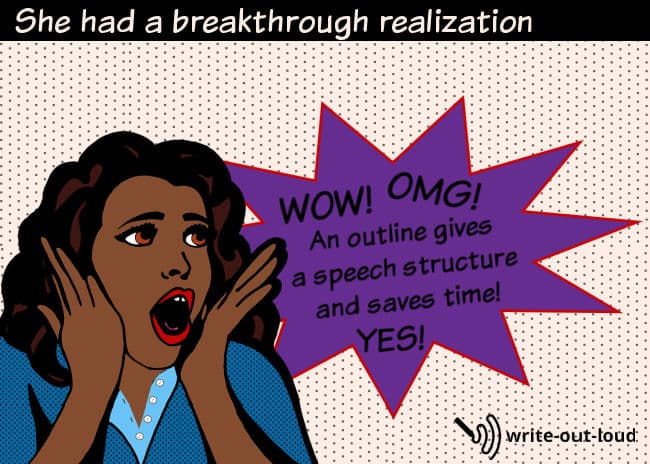
It is often overlooked in a misguided attempt to get on with what is considered the real work: writing the speech, or the words you're going to say.
Despite what many people think, time spent completing an outline is not wasted. Instead, it helps you save it. A nd sidestep any anxiety caused by inadequate preparation.
The process might appear daunting and horrifically time consuming but prepare a speech outline all the same.☺
What you'll learn about speech structure, matching content to your speech purpose and your audience's needs will pay you back over and over again. I promise you, having an outline will make giving a speech easier and less stressful.
How to best use this page
Read the page all the way through to familiarize yourself with the terms and the process. When you're done, click the link at the foot of the page to download and print the blank sample speech outline template for your own use.
How to outline a speech: 4 essential steps
The process of outlining a speech is broken down into 4 essential steps.
(Click a heading to find out more about each one)
- deciding on your topic
- considering the audience and refining your topic to suit them
- deciding on the purpose of the speech
- choosing an organizational method to support your speech purpose
- opening greeting and attention getter
- defining your thesis statement (a summary of what your speech is about)
- establishing your credibility
- an overview and the benefit to the audience
- transition or link between introduction and body
- main ideas with supporting ideas
- examples and details
- summary of main points
- closer or call to action
Remember this old saying?
First: tell them what you're going to tell them. Second: tell them. Third: tell them what you told them.
A simple, or basic, speech outline follows that advice.
- 'Tell them what you're going to tell them' becomes your introduction
- 'Tell them' forms the body
- 'Tell them what you told them' is your conclusion
Step 1 - Preparation for writing a speech outline
You need to complete this step before you do anything else. It is made up of five smaller steps, each of them an important part of the overall process. The decisions you make at this point will have a major impact on the final outcome of your speech.
By the time you are finished step 1 you will have:
- decided on your topic
- analyzed your audience
- refined your topic to meet the needs of your audience
- decided on the specific purpose of your speech
- chosen the best fitting of six organizational patterns to use - one matching your purpose and your material
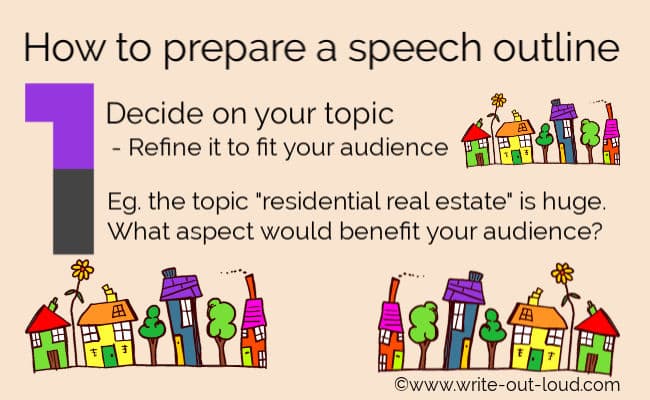
Start with choosing a topic
The place to begin is deciding what you are going to talk about.
For example, if you are a realtor (real estate agent) who has been asked to talk to a suburban community group residential real estate seems like a good logical topic to pick.
(If you don't have a topic in mind, go to speech topics . You'll find 100s of them ordered by speech type and theme.)
Put yourself to one side & focus on your audience
However, before you make a final decision considering more closely who will be listening to you makes better sense than assuming whatever you come up with will be right!
How do you really know what aspects of your topic are best suited to meet your audience's needs? Or what would be of real benefit for them to hear about?
The scope of the topic 'residential real estate' is huge.
Your speech could cover any number of sub-topics like: financial advice for first home buyers, how to thoroughly check a house before purchase, the rise of mortgagee default sales, the collapse of property development schemes, how to purchase properties for makeovers...
Analyze your audience
So before you settle on the exact topic of your speech analyze your audience .
Without analysis you are 'guessing' what would be interesting and relevant for them to hear.
Refine your topic
Using what you found out about your audience, decide on an aspect of your topic that will be of benefit to them and the angle you will take on it. Take care with this. One size does not fit all!
For example a speech on housing affordability which includes a step by step plan toward buying a first home will likely interest an audience of youngish, (late 20s- early 40s), people with steady professional incomes.
But for another audience, (e.g. one that is older, less financially secure, or younger and not ready to consider settling yet...), it could be completely inappropriate.
Minimize the risk of getting it wrong by finding out as much as you can about your audience.
Deciding on the purpose of your speech
What is the purpose of this speech? Why are you giving it?
Is it to persuade or inform? Is it to demonstrate, entertain, or welcome? Or is it a combination of these?
What do you want your speech to achieve? Is there a particular action you want people to take as a result of listening to you?
Your answers to all of these questions will dictate what organizational pattern you'll use for your speech, its content and tone.
Return to Top
Choosing an organizational pattern or method

There are 6 basic organizational patterns or methods of arranging the body (main points) of your material. Choose the one most appropriate for your need.
1. Cause - Effect
Because event 'A' happened, event 'B' occurred.
- Because the driver was speeding, they crashed the car.
- Because of the earthquake, the city was destroyed.
- Because the minimum wage is low, families can not afford good health care.
2. Problem - Solution
The problem is 'X'. The answer is 'Y'.
- The problem is unaffordable housing. The solution is community funded housing complexes.
- The problem is unemployment. The solution is meaningful, sustainable education and employment programs.
- The problem is poor food choices. The solution is practical community outreach programs to teach people about nutrition, food buying, storage and preparation, along side living wages, educational and employment programs.
This pattern suits a broad topic which can be broken down into naturally occurring sub-topics.
- The broad topic is 'Vocal Variety'. Its sub-topics include rate of speech, use of pausing, voice tone, volume, articulation...
- The broad topic is 'Organizational speech patterns'. Sub-topics could be problem-solution, cause- effect, logical...
- The broad topic is 'Residential real estate'. Its sub-topics could include houses for first-home buyers, how to apply for a mortgage, how to select the right neighborhood to buy in, the impact of high-density housing...
4. Spatial or geographic
Use this pattern for topics dealing with physical spaces.
- The 10 most popular tourist attractions in New Zealand.
- The European migration patterns of the 19th century.
- The population shift from country to town in USA.
5. Time or chronological/sequential
These are either historical topics or demonstration speeches. The foundation of both is an ordered sequence of events.
For example:
- The history of women's suffrage in USA, the abolition of slavery
- How to bake a cake, how to mend a puncture in a bicycle tire, or how to knot a tie
6. Advantage - disadvantage
Use this pattern to examine the range of positive and negative aspects of an idea or event.
- What are the advantages and disadvantages of private schooling?
- What are the advantages and disadvantages of lowering the voting age?
- What is good about supporting local industry? What is negative about supporting local industry?
Step Two - Outlining the introduction
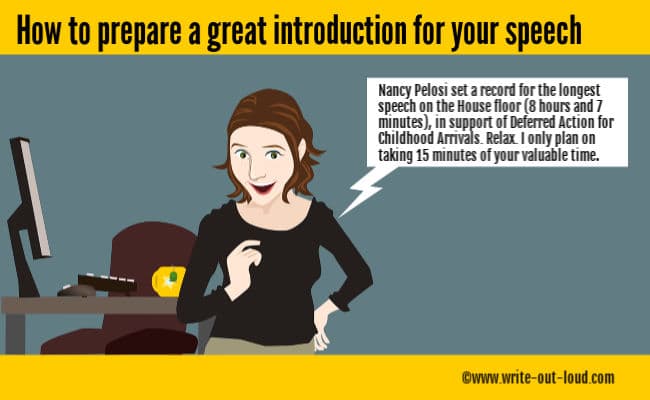
The 5 parts of preparing an introduction
1. greeting & attention getter.
How are you going to greet your audience, grab their attention and compel them to listen?
You could use a rhetorical question, a startling statistic, a quotation or a humorous one-liner. To be effective it must be related to your topic and apt for your audience.
- Rhetorical question How many of you really are more afraid of public speaking than death?
- A startling statistic Apparently in USA 75% of the population experiences public speaking anxiety. Some just a little. And some a lot.
- A quotation Mark Twain famously said, there are only two types of speakers in the world: the nervous and the liars.
- Humorous Speaker of United States House of Representatives, Nancy Pelosi set a record for the longest speech on the House floor: 8 hours and 7 minutes. Relax. I only plan on taking 15 minutes of your valuable time. * * Be careful with humor. It will only work if it's appropriate; that is fitting for the occasion, and understood by the majority of your audience. For more about Nancy's record: Nancy Pelosi's all-day marathon speech sets record as longest continuous speech since at least 1909.
For more on effective speech openings see: How to write a speech introduction - 12 of the best ways to start a speech
2. Thesis statement
This is a short summary of your speech topic and your point of view or angle.
Example:
Green politics is no longer a fanciful fringe fad. It is a necessity.
3. Credibility
This segment establishes your right to speak on the topic. It cites your qualification or expertise.
Using myself as an example, I can speak about preparing speeches because I've written many over the past twenty or so years. Prior to becoming a professional speech writer , I taught high school level English and drama and I also belonged to the global public speaking club Toastmasters for a long time.
4. Summative overview
This is a brief outline of the main points you are going to cover.
Today I am going to share with you three effective ways to lessen public speaking fear.
The first and second cover aspects of preparation: writing and rehearsal or practice: actually doing the work, rather than being frightened of it. ☺ The third is about the benefits of public speaking.
5. Benefit(s)
What's in your speech for your audience? Why will they want to hear what you've got to tell them? Be specific. Tell them.
When you make a decision to speak up in public you also gain: confidence, the ability to take on leadership roles, a growing collection of presentation skills like story telling, how to use your voice, the ability to use props well, how to listen, how to craft a speech to meet the needs of specific audiences... In short, you release the potential to become a bigger and better you * .
( * For more see 14 benefits of public speaking .)
Step Three - Outlining the body of your speech
This is the heart of your speech, the place where you lay out what you want to share with your audience.
Generally three main ideas, along with supporting examples, work more effectively than four or five or more. If you have a number of them to choose from, go with your three strongest points. And if one of your final three is noticeably weaker sandwich it between the other two.
If you intend to use visual aids (slides showing graphs, tables or images), or actual props, mark them in too.
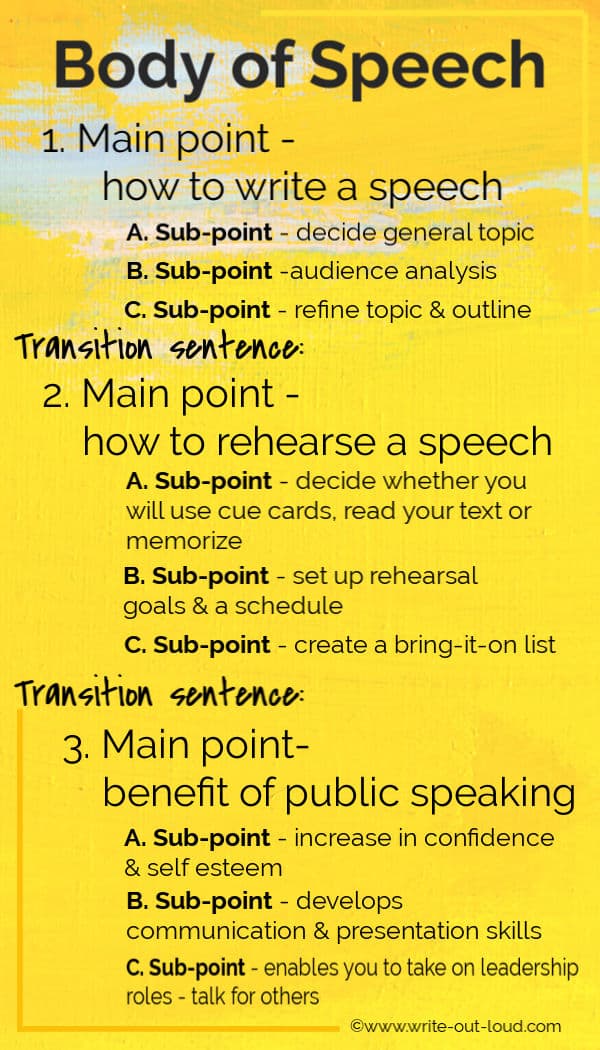
Note: If you're unsure about the exact nature of links or transitions and how they work or what they are, you'll find more about them, with examples, on my page how to write a speech
- Main Idea 3 - Supporting ideas - Details and examples - Visuals or props - Transition to...
Step Four - Outlining the conclusion of your speech
There are four parts to preparing an effective conclusion to your speech. Use them to draw together and summarize all the material from your introduction and the body of your speech, and end with a clincher!
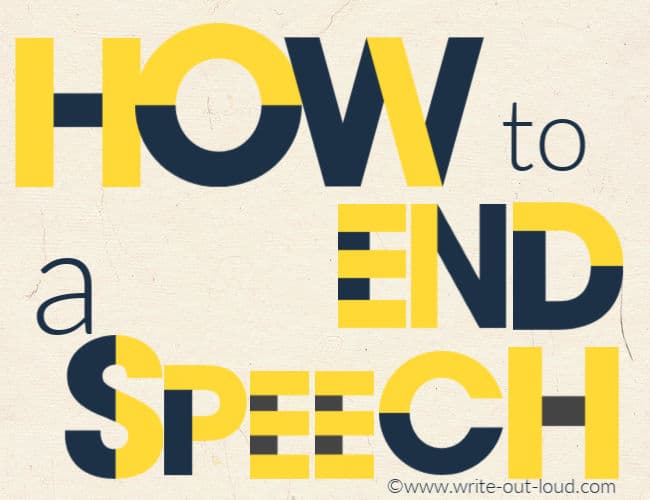
- Summary of main ideas These are the main points you covered in the body of your speech.
- Re-statement of thesis statement Use the statement from your introduction to reinforce your message.
- Re-statement of benefit to audience Remind the audience of the benefits they'll receive through carrying out whatever your propose. Again this comes from your introduction.
- Closer, Clincher or Call to Action This is your final sentence. To ensure your speech ends with a bang rather than a whimper check out this page on how to end a speech memorably. You'll find options and examples.
Get your printable sample speech outline template
This is a simple four page PDF of all four steps and their sub- headings with spaces for you to write your notes. Click to download and print your sample speech outline now.
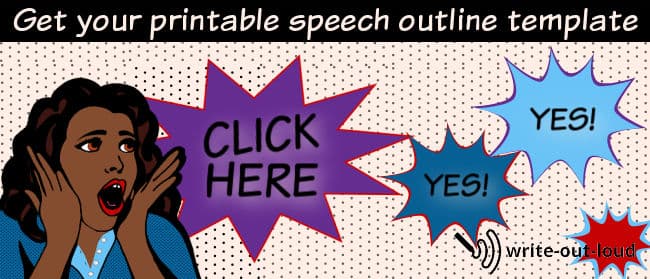
2 completed examples of speech outlines
Use these links to go to a fully completed:
- demonstration speech outline example on how to leave an effective voice mail message (with a free printable sequential demonstration speech outline template)
- persuasive speech topic outline example on overcoming public speaking fear using Monroe's Motivated Sequence (with a free printable MMS persuasive speech outline template)
Example impromptu speech outline patterns
Impromptu speech outline patterns - seven different structural formats, each with completed examples and a free blank printable outline for you to download and use.

Other resources for preparing successful speeches
Planning and writing, rehearsing a speech.
Once you're done with planning, completing your sample speech outline and writing find out how to rehearse. A speech is a live performance. Rehearsal helps you expose and iron out glitches before you find them out the hard way - in front of your audience.
Speech evaluation
And if your speech is being assessed check out this standard speech evaluation form to see what aspects are likely to be judged and how a rating scale works.
- Return to the top
speaking out loud
Subscribe for FREE weekly alerts about what's new For more see speaking out loud

Top 10 popular pages
- Welcome speech
- Demonstration speech topics
- Impromptu speech topic cards
- Thank you quotes
- Impromptu public speaking topics
- Farewell speeches
- Phrases for welcome speeches
- Student council speeches
- Free sample eulogies
From fear to fun in 28 ways
A complete one stop resource to scuttle fear in the best of all possible ways - with laughter.

Useful pages
- Search this site
- About me & Contact
- Blogging Aloud
- Free e-course
- Privacy policy
©Copyright 2006-24 www.write-out-loud.com
Designed and built by Clickstream Designs

How to Write an Effective Speech Outline: A Step-by-Step Guide
- The Speaker Lab
- March 8, 2024
Table of Contents
Mastering the art of speaking starts with crafting a stellar speech outline. A well-structured outline not only clarifies your message but also keeps your audience locked in.
In this article, you’ll learn how to mold outlines for various speech types, weaving in research that resonates and transitions that keep listeners on track. We’ll also show you ways to spotlight crucial points and manage the clock so every second counts. When it’s time for final prep, we’ve got smart tips for fine-tuning your work before stepping into the spotlight.
Understanding the Structure of a Speech Outline
An effective speech outline is like a map for your journey as a speaker, guiding you from start to finish. Think of it as the blueprint that gives shape to your message and ensures you hit all the right notes along the way.
Tailoring Your Outline for Different Speech Types
Different speeches have different goals: some aim to persuade, others inform or celebrate. Each type demands its own structure in an outline. For instance, a persuasive speech might highlight compelling evidence while an informative one focuses on clear explanations. Crafting your outline with precision means adapting it to fit these distinct objectives.
Incorporating Research and Supporting Data
Your credibility hinges on solid research and data that back up your claims. When writing your outline, mark the places where you’ll incorporate certain pieces of research or data. Every stat you choose should serve a purpose in supporting your narrative arc. And remember to balance others’ research with your own unique insights. After all, you want your work to stand out, not sound like someone else’s.
The Role of Transitions in Speech Flow
Slick transitions are what turn choppy ideas into smooth storytelling—think about how bridges connect disparate land masses seamlessly. They’re not just filler; they carry listeners from one thought to another while maintaining momentum.
Incorporate transitions that feel natural yet keep people hooked. To keep things smooth, outline these transitions ahead of time so nothing feels left up to chance during delivery.
Techniques for Emphasizing Key Points in Your Outline
To make certain points pop off the page—and stage—you’ll need strategies beyond bolding text or speaking louder. Use repetition wisely or pause strategically after delivering something significant. Rather than go impromptu, plan out what points you want to emphasize before you hit the stage.
Timing Your Speech Through Your Outline
A watchful eye on timing ensures you don’t overstay—or undercut—your moment under the spotlight. The rhythm set by pacing can be pre-determined through practice runs timed against sections marked clearly in outlines. Practice will help ensure that your grand finale isn’t cut short by surprise.
Free Download: 6 Proven Steps to Book More Paid Speaking Gigs in 2024
Download our 18-page guide and start booking more paid speaking gigs today!
Depending on the type of speech you’re giving, your speech outline will vary. The key ingredients—introduction, body, and conclusion—are always there, but nuances like tone or message will change with each speaking occasion.
Persuasive Speeches: Convincing With Clarity
When outlining a persuasive speech, arrange your arguments from strong to strongest. The primacy effect works wonders here, so make sure to start off with a strong point. And just when they think they’ve heard it all, hit them with an emotional story that clinches the deal.
You might start by sharing startling statistics about plastic pollution before pivoting to how individuals can make a difference. Back this up with data on successful recycling programs which demonstrate tangible impact, a technique that turns facts into fuel for action.
Informative Speeches: Educating Without Overwhelming
An informative speech shouldn’t feel like drinking from a fire hose of facts and figures. Instead, lay out clear subtopics in your outline and tie them together with succinct explanations—not unlike stepping stones across a stream of knowledge.
If you’re talking about breakthroughs in renewable energy technology, use bullet points to highlight different innovations then expand upon their potential implications one at a time so the audience can follow along without getting lost in technical jargon or complexity.
Ceremonial Speeches: Creating Moments That Matter
In a ceremonial speech you want to capture emotion. Accordingly, your outline should feature personal anecdotes and quotes that resonate on an emotional level. However, make sure to maintain brevity because sometimes less really is more when celebrating milestones or honoring achievements.
Instead of just going through a hero’s whole life story, share the powerful tales of how they stepped up in tough times. This approach hits home for listeners, letting them feel the impact these heroes have had on their communities and sparking an emotional bond.
Incorporating Research in Your Speech Outline
When you’re crafting a speech, the backbone of your credibility lies in solid research and data. But remember, it’s not just about piling on the facts. It’s how you weave them into your narrative that makes listeners sit up and take notice.
Selecting Credible Sources
Finding trustworthy sources is like going on a treasure hunt where not all that glitters is gold. To strike real gold, aim for academic journals or publications known for their rigorous standards. Google Scholar or industry-specific databases are great places to start your search. Be picky. Your audience can tell when you’ve done your homework versus when you’ve settled for less-than-stellar intel.
You want to arm yourself with evidence so compelling that even skeptics start nodding along. A well-chosen statistic from a reputable study does more than decorate your point—it gives it an ironclad suit of armor.
Organizing Information Effectively
Your outline isn’t just a roadmap; think of it as scaffolding that holds up your argument piece by piece. Start strong with an eye-opening factoid to hook your audience right off the bat because first impressions matter—even in speeches.
To keep things digestible, group related ideas together under clear subheadings within your outline. Stick to presenting data that backs up each key idea without wandering down tangential paths. That way, everyone stays on track.
Making Data Relatable
Sure, numbers don’t lie but they can be hard to connect to. If you plan on using stats in your speech, make them meaningful by connecting them to relatable scenarios or outcomes people care about deeply. For instance, if you’re talking health statistics, relate them back to someone’s loved ones or local hospitals. By making the personal connection for your audience, you’ll get their attention.
The trick is using these nuggets strategically throughout your talk, not dumping them all at once but rather placing each one carefully where its impact will be greatest.
Imagine your speech as a road trip. Without smooth roads and clear signs, the journey gets bumpy, and passengers might miss the scenery along the way. That’s where transitions come in. They’re like your speech’s traffic signals guiding listeners from one point to another.
Crafting Seamless Bridges Between Ideas
Transitions are more than just linguistic filler. They’re strategic connectors that carry an audience smoothly through your narrative. Start by using phrases like “on top of this” or “let’s consider,” which help you pivot naturally between points without losing momentum.
To weave these seamlessly into your outline, map out each major turn beforehand to ensure no idea is left stranded on a tangent.
Making Use of Transitional Phrases Wisely
Be cautious: overusing transitional phrases can clutter up your speech faster than rush hour traffic. Striking a balance is key—think about how often you’d want to see signposts on a highway. Enough to keep you confident but not so many that it feels overwhelming.
Pick pivotal moments for transitions when shifting gears from one major topic to another or introducing contrasting information. A little direction at critical junctures keeps everyone onboard and attentive.
Leveraging Pauses as Transition Tools
Sometimes silence speaks louder than words, and pauses are powerful tools for transitioning thoughts. A well-timed pause lets ideas resonate and gives audiences time to digest complex information before moving forward again.
This approach also allows speakers some breathing room themselves—the chance to regroup mentally before diving into their next point with renewed vigor.
Connecting Emotional Threads Throughout Your Speech
Last but not least, don’t forget emotional continuity, that intangible thread pulling heartstrings from start-to-finish. Even if topics shift drastically, maintaining an underlying emotional connection ensures everything flows together cohesively within the larger tapestry of your message.
Techniques for Emphasizing Key Points in Your Speech Outline
When you’re crafting your speech outline, shine a spotlight on what matters most so that your audience doesn’t miss your key points.
Bold and Italicize for Impact
You wouldn’t whisper your punchline in a crowded room. Similarly, why let your main ideas get lost in a sea of text? Use bold or italics to give those lines extra weight. This visual cue signals importance, so when you glance at your notes during delivery, you’ll know to emphasize those main ideas.
Analogies That Stick
A good analogy is like super glue—it makes anything stick. Weave them into your outline and watch as complex concepts become crystal clear. But remember: choose analogies that resonate with your target audience’s experiences or interests. The closer home it hits, the longer it lingers.
The Power of Repetition
If something’s important say it again. And maybe even once more after that—with flair. Repetition can feel redundant on paper, but audiences often need to hear critical messages several times before they take root.
Keep these strategies in mind when you’re ready to dive into your outline. You’ll transform those core ideas into memorable insights before you know it.
Picture this: you’re delivering a speech, and just as you’re about to reach the end, your time’s up. Ouch! Let’s make sure that never happens. Crafting an outline is not only about what to say but also how long to say it.
Finding Balance in Section Lengths
An outline isn’t just bullet points; it’s a roadmap for pacing. When outlining your speech, make sure to decide how much time you’d like to give each of your main points. You might even consider setting specific timers during rehearsals to get a real feel for each part’s duration. Generally speaking, you should allot a fairly equal amount of time for each to keep things balanced.
The Magic of Mini Milestones
To stay on track, a savvy speaker will mark time stamps or “mini milestones” on their outline. These time stamps give the speaker an idea of where should be in their speech by the time, say, 15 minutes has passed. If by checkpoint three you should be 15 minutes deep and instead you’re hitting 20 minutes, it’s time to pick up the pace or trim some fat from earlier sections. This approach helps you stay on track without having to glance at the clock after every sentence.
Utilizing Visual Aids and Multimedia in Your Outline
Pictures speak louder than words, especially when you’re on stage. Think about it: How many times have you sat through a presentation that felt like an eternity of endless bullet points? Now imagine if instead, there was a vibrant image or a short video clip to break up the monotony—it’s game-changing. That’s why integrating visual aids and multimedia into your speech outline isn’t just smart. It’s crucial for keeping your audience locked in.
Choosing Effective Visuals
Selecting the right visuals is not about flooding your slides with random images but finding those that truly amplify your message. Say you’re talking about climate change. In this case, a graph showing rising global temperatures can hit hard and illustrate your chosen statistic clearly. Remember, simplicity reigns supreme; one powerful image will always trump a cluttered collage.
Multimedia Magic
Videos are another ace up your sleeve. They can deliver testimonials more powerfully than quotes or transport viewers to places mere descriptions cannot reach. But be warned—timing is everything. Keep clips short and sweet because no one came to watch a movie—they came to hear you . You might highlight innovations using short video snippets, ensuring these moments serve as compelling punctuations rather than pauses in your narrative.
The Power of Sound
We often forget audio when we think multimedia, yet sound can evoke emotions and set tones subtly yet effectively. Think striking chords for dramatic effect or nature sounds for storytelling depth during environmental talks.
Audiences crave experiences they’ll remember long after they leave their seats. With well-chosen visuals and gripping multimedia elements woven thoughtfully into every section of your speech outline, you’ll give them exactly that.
Rehearsing with Your Speech Outline
When you’re gearing up to take the stage, your speech outline is a great tool to practice with. With a little preparation, you’ll give a performance that feels both natural and engaging.
Familiarizing Yourself with Content
To start off strong, get cozy with your outline’s content. Read through your outline aloud multiple times until the flow of words feels smooth. This will help make sure that when showtime comes around, you can deliver those lines without tripping over tough transitions or complex concepts.
Beyond mere memorization, understanding the heart behind each point allows you to speak from a place of confidence. You know this stuff—you wrote it. Now let’s bring that knowledge front and center in an authentic way.
Mimicking Presentation Conditions
Rehearsing under conditions similar to those expected during the actual presentation pays off big time. Are you going to stand or roam about? Will there be a podium? Think about these details and simulate them during rehearsal because comfort breeds confidence—and we’re all about boosting confidence.
If technology plays its part in your talk, don’t leave them out of rehearsals either. The last thing anyone needs is tech trouble during their talk.
Perfecting Pace Through Practice
Pacing matters big time when speaking. Use timed rehearsals to nail down timing. Adjust speed as needed but remember: clarity trumps velocity every single time.
You want people hanging onto every word, which is hard to do if you’re talking so fast they can barely make out what you’re saying. During rehearsals, find balance between pacing and comprehension; they should go hand-in-hand.
Finalizing Your Speech Outline for Presentation
You’ve poured hours into crafting your speech, shaping each word and idea with precision. Now, it’s time to tighten the nuts and bolts. Finalizing your outline isn’t just about dotting the i’s and crossing the t’s. It’s about making sure your message sticks like a perfectly thrown dart.
Reviewing Your Content for Clarity
Your first task is to strip away any fluff that might cloud your core message. Read through every point in your outline with a critical eye. Think of yourself as an editor on a mission to cut out anything that doesn’t serve a purpose. Ask yourself if you can explain each concept clearly without needing extra words or complex jargon. If not, simplify.
Strengthening Your Argument
The meat of any good presentation lies in its argument, the why behind what you’re saying. Strengthen yours by ensuring every claim has iron-clad backing—a stat here, an expert quote there. Let this be more than just facts tossed at an audience; weave them into stories they’ll remember long after they leave their seats.
Crafting Memorable Takeaways
Audiences may forget details but never how you made them feel—or think. Embed memorable takeaways throughout your outline so when folks step out into fresh air post-talk, they carry bits of wisdom with them.
This could mean distilling complex ideas down to pithy phrases or ending sections with punchy lines that resonate. It’s these golden nuggets people will mine for later reflection.
FAQs on Speech Outlines
How do you write a speech outline.
To craft an outline, jot down your main ideas, arrange them logically, and add supporting points beneath each.
What are the 3 main parts of a speech outline?
An effective speech has three core parts: an engaging introduction, a content-rich body, and a memorable conclusion.
What are the three features of a good speech outline?
A strong outline is clear, concise, and structured in logical sequence to maximize impact on listeners.
What is a working outline for a speech?
A working outline serves as your blueprint while preparing. It’s detailed but flexible enough to adjust as needed.
Crafting a speech outline is like drawing your map before the journey. It starts with structure and flows into customization for different types of talks. Remember, research and evidence are your compass—they guide you to credibility. Transitions act as bridges, connecting one idea to another smoothly. Key points? They’re landmarks so make them shine.
When delivering your speech, keep an eye on the clock and pace yourself so that every word counts.
Multimedia turns a good talk into a great show. Rehearsing polishes that gem of a presentation until it sparkles.
Last up: fine-tuning your speech outline means you step out confident, ready to deliver something memorable because this isn’t just any roadmap—it’s yours.
- Last Updated: March 5, 2024

Explore Related Resources
Learn How You Could Get Your First (Or Next) Paid Speaking Gig In 90 Days or Less
We receive thousands of applications every day, but we only work with the top 5% of speakers .
Book a call with our team to get started — you’ll learn why the vast majority of our students get a paid speaking gig within 90 days of finishing our program .
If you’re ready to control your schedule, grow your income, and make an impact in the world – it’s time to take the first step. Book a FREE consulting call and let’s get you Booked and Paid to Speak ® .
About The Speaker Lab
We teach speakers how to consistently get booked and paid to speak. Since 2015, we’ve helped thousands of speakers find clarity, confidence, and a clear path to make an impact.
Get Started
Let's connect.
Copyright ©2023 The Speaker Lab. All rights reserved.

COMM 101: Fundamentals of Public Speaking - Valparaiso
- Delivery Skills
- Stage Fright
- Body Language / Non-Verbal Communication
- Listening Skills
- Quotation Resources
- Speech Outline Examples
- Speech Examples
- More Speech Examples
- Presentation Options
- Citation Resources This link opens in a new window
A basic speech outline should include three main sections:
- The Introduction -- This is where you tell them what you're going to tell them.
- The Body -- This is where you tell them.
- The Conclusion -- This is where you tell them what you've told them.
- Speech Outline Formatting Guide The outline for a public speech, according to COMM 101 online textbook The Public Speaking Project , p.p. 8-9.
Use these samples to help prepare your speech outlines and bibliographies:
- Sample Speech Preparation Outline This type of outline is very detailed with all the main points and subpoints written in complete sentences. Your bibliography should be included with this outline.
- Sample Speech Speaking Outline This type of outline is very brief and uses phrases or key words for the main points and subpoints. This outline is used by the speaker during the speech.
- << Previous: Quotation Resources
- Next: Informative Speeches >>
- Last Updated: May 16, 2024 10:02 AM
- URL: https://library.ivytech.edu/Valpo_COMM101
- Ask-a-Librarian
- [email protected]
- (219) 464-8514 x 3021
- Library staff | Find people
- Library Guides
- Student Life & Activities
- Testing Services
- B&N Bookstore
Informative Speech
Informative Speech Outline
Informative Speech Outline - Format, Writing Steps, and Examples

People also read
Informative Speech Writing - A Complete Guide
Good Informative Speech Topics & Ideas
Collection of Ideas and ‘How To’ Demonstrative Speech Topics
10+ Informative Speech Examples - Get Inspiration For Any Type
Understanding Different Types of Informative Speeches with Examples
Are you tasked with delivering an informative speech but don’t know how to begin? You're in the right place!
This type of speech aims to inform and educate the audience about a particular topic. It conveys knowledge about that topic in a systematic and logical way, ensuring that the audience gets the intended points comprehensively.
So, how do you prepare for your speech? Here’s the answer: crafting an effective informative speech begins with a well-structured outline.
In this guide, we'll walk you through the process of creating an informative speech outline, step by step. Plus, you’ll get some amazing informative speech outline examples to inspire you.
Let’s get into it!
- 1. What is an Informative Speech Outline?
- 2. How to Write an Informative Speech Outline?
- 3. Informative Speech Outline Examples
What is an Informative Speech Outline?
An informative speech outline is like a roadmap for your presentation. It's a structured plan that helps you organize your thoughts and information in a clear and logical manner.
Here's what an informative speech outline does:
- Organizes Your Ideas: It helps you arrange your thoughts and ideas in a logical order, making it easier for your audience to follow your presentation.
- Ensures Clarity: An outline ensures that your speech is clear and easy to understand. It prevents you from jumping from one point to another without a clear path.
- Saves Time: With a well-structured outline, you'll spend less time searching for what to say next during your speech. It's your cheat sheet.
- Keeps Your Audience Engaged: A well-organized outline keeps your audience engaged and focused on your message. It's the key to a successful presentation.
- Aids Memorization: Having a structured outline can help you remember key points and maintain a confident delivery.
How to Write an Informative Speech Outline?
Writing a helpful speech outline is not so difficult if you know what to do. Here are 4 simple steps to craft a perfect informative outline.
Step 1: Choose an Engaging Topic
Selecting the right topic is the foundation of a compelling, informative speech. Choose unique and novel informative speech topics that can turn into an engaging speech.
Here's how to do it:
- Consider Your Audience: Think about the interests, knowledge, and expectations of your audience. What would they find interesting and relevant?
- Choose Your Expertise: Opt for a topic you're passionate about or knowledgeable in. Your enthusiasm will shine through in your presentation.
- Narrow It Down: Avoid broad subjects. Instead, focus on a specific aspect of the topic to keep your speech manageable and engaging.
With these tips in mind, you can find a great topic for your speech.

Step 2: Conduct Some Research
Now that you have your topic, it's time to gather the necessary information. You need to do thorough research and collect some credible information necessary for the audience to understand your topic.
Moreover, understand the types of informative speeches and always keep the main purpose of your speech in mind. That is, to inform, educate, or teach. This will help you to avoid irrelevant information and stay focused on your goal.
Step 3: Structure Your Information
Now that you have the required information to make a good speech, you need to organize it logically. This is where the outlining comes in!
The basic speech format consists of these essential elements:
Moreover, there are two different ways to write your outline:
- The complete sentence format
- The key points format
In the complete sentence outline , you write full sentences to indicate each point and help you check the organization and content of the speech.
In the key points format, you just note down the key points and phrases that help you remember what you should include in your speech.
Step 4: Review and Revise
Finally, once you've created your initial informative speech outline, you need to review and revise it.
Here's how to go about it:
- Ensure Clarity: Review your outline to ensure that your main points and supporting details are clear and easy to understand.
- Verify Logical Sequence: Double-check the order of your points and transitions. Ensure that the flow of your speech is logical and that your audience can follow it easily.
- Eliminate Redundancy: Remove any redundant or repetitive information. Keep your outline concise and to the point.
- Time Yourself: Estimate how long it will take to deliver your speech. Ensure it fits within the allotted time frame, whether it's a few minutes or an hour.
- Get Feedback: Share your outline with a friend, family member, or colleague and ask for their input. Fresh eyes can provide valuable suggestions for improvement.
Follow these basic steps and write a compelling speech that gives complete knowledge about the topic. Here is a sample outline example that will help you better understand how to craft an informative speech outline.
Informative Speech Outline Format
Informative Speech Outline Examples
Let’s explore a few example outlines to help you visualize an informative speech outline. These examples illustrate the outlines for different topics and subjects.
Mental Health Informative Speech Outline
Stress Informative Speech Outline
Social Media Informative Speech Outline
Informative Speech Outline Template
Informative Speech Outline Sample
To sum it up,
Creating an effective outline is your pathway to delivering an impactful, organized, and engaging speech. Making an outline for your speech ensures that your message shines through with clarity and purpose.
With the help of the steps and examples given above, you will be able to create a well-structured outline for your informative speech. So go ahead and deliver an engaging informative speech with the help of outlines.
Moreover, if you're passionate about public speaking but find speech writing a tedious task, your worries can now take a back seat. At MyPerfectWords.com , we offer a convenient solution.
Our essay writing service is dedicated to providing you with top-notch content, ensuring you get the results you desire.
So, why wait? Buy Speech today and elevate your public speaking game.

Write Essay Within 60 Seconds!

Cathy has been been working as an author on our platform for over five years now. She has a Masters degree in mass communication and is well-versed in the art of writing. Cathy is a professional who takes her work seriously and is widely appreciated by clients for her excellent writing skills.

Paper Due? Why Suffer? That’s our Job!
Keep reading
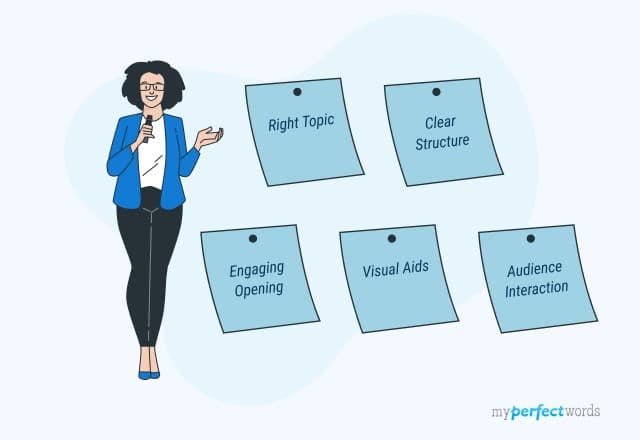

Improve your practice.
Enhance your soft skills with a range of award-winning courses.
Persuasive Speech Outline, with Examples
March 17, 2021 - Gini Beqiri
A persuasive speech is a speech that is given with the intention of convincing the audience to believe or do something. This could be virtually anything – voting, organ donation, recycling, and so on.
A successful persuasive speech effectively convinces the audience to your point of view, providing you come across as trustworthy and knowledgeable about the topic you’re discussing.
So, how do you start convincing a group of strangers to share your opinion? And how do you connect with them enough to earn their trust?
Topics for your persuasive speech
We’ve made a list of persuasive speech topics you could use next time you’re asked to give one. The topics are thought-provoking and things which many people have an opinion on.
When using any of our persuasive speech ideas, make sure you have a solid knowledge about the topic you’re speaking about – and make sure you discuss counter arguments too.
Here are a few ideas to get you started:
- All school children should wear a uniform
- Facebook is making people more socially anxious
- It should be illegal to drive over the age of 80
- Lying isn’t always wrong
- The case for organ donation
Read our full list of 75 persuasive speech topics and ideas .

Preparation: Consider your audience
As with any speech, preparation is crucial. Before you put pen to paper, think about what you want to achieve with your speech. This will help organise your thoughts as you realistically can only cover 2-4 main points before your audience get bored .
It’s also useful to think about who your audience are at this point. If they are unlikely to know much about your topic then you’ll need to factor in context of your topic when planning the structure and length of your speech. You should also consider their:
- Cultural or religious backgrounds
- Shared concerns, attitudes and problems
- Shared interests, beliefs and hopes
- Baseline attitude – are they hostile, neutral, or open to change?
The factors above will all determine the approach you take to writing your speech. For example, if your topic is about childhood obesity, you could begin with a story about your own children or a shared concern every parent has. This would suit an audience who are more likely to be parents than young professionals who have only just left college.
Remember the 3 main approaches to persuade others
There are three main approaches used to persuade others:
The ethos approach appeals to the audience’s ethics and morals, such as what is the ‘right thing’ to do for humanity, saving the environment, etc.
Pathos persuasion is when you appeal to the audience’s emotions, such as when you tell a story that makes them the main character in a difficult situation.
The logos approach to giving a persuasive speech is when you appeal to the audience’s logic – ie. your speech is essentially more driven by facts and logic. The benefit of this technique is that your point of view becomes virtually indisputable because you make the audience feel that only your view is the logical one.
- Ethos, Pathos, Logos: 3 Pillars of Public Speaking and Persuasion
Ideas for your persuasive speech outline
1. structure of your persuasive speech.
The opening and closing of speech are the most important. Consider these carefully when thinking about your persuasive speech outline. A strong opening ensures you have the audience’s attention from the start and gives them a positive first impression of you.
You’ll want to start with a strong opening such as an attention grabbing statement, statistic of fact. These are usually dramatic or shocking, such as:
Sadly, in the next 18 minutes when I do our chat, four Americans that are alive will be dead from the food that they eat – Jamie Oliver
Another good way of starting a persuasive speech is to include your audience in the picture you’re trying to paint. By making them part of the story, you’re embedding an emotional connection between them and your speech.
You could do this in a more toned-down way by talking about something you know that your audience has in common with you. It’s also helpful at this point to include your credentials in a persuasive speech to gain your audience’s trust.

Obama would spend hours with his team working on the opening and closing statements of his speech.
2. Stating your argument
You should pick between 2 and 4 themes to discuss during your speech so that you have enough time to explain your viewpoint and convince your audience to the same way of thinking.
It’s important that each of your points transitions seamlessly into the next one so that your speech has a logical flow. Work on your connecting sentences between each of your themes so that your speech is easy to listen to.
Your argument should be backed up by objective research and not purely your subjective opinion. Use examples, analogies, and stories so that the audience can relate more easily to your topic, and therefore are more likely to be persuaded to your point of view.
3. Addressing counter-arguments
Any balanced theory or thought addresses and disputes counter-arguments made against it. By addressing these, you’ll strengthen your persuasive speech by refuting your audience’s objections and you’ll show that you are knowledgeable to other thoughts on the topic.
When describing an opposing point of view, don’t explain it in a bias way – explain it in the same way someone who holds that view would describe it. That way, you won’t irritate members of your audience who disagree with you and you’ll show that you’ve reached your point of view through reasoned judgement. Simply identify any counter-argument and pose explanations against them.
- Complete Guide to Debating
4. Closing your speech
Your closing line of your speech is your last chance to convince your audience about what you’re saying. It’s also most likely to be the sentence they remember most about your entire speech so make sure it’s a good one!
The most effective persuasive speeches end with a call to action . For example, if you’ve been speaking about organ donation, your call to action might be asking the audience to register as donors.
Practice answering AI questions on your speech and get feedback on your performance .
If audience members ask you questions, make sure you listen carefully and respectfully to the full question. Don’t interject in the middle of a question or become defensive.
You should show that you have carefully considered their viewpoint and refute it in an objective way (if you have opposing opinions). Ensure you remain patient, friendly and polite at all times.
Example 1: Persuasive speech outline
This example is from the Kentucky Community and Technical College.
Specific purpose
To persuade my audience to start walking in order to improve their health.
Central idea
Regular walking can improve both your mental and physical health.
Introduction
Let’s be honest, we lead an easy life: automatic dishwashers, riding lawnmowers, T.V. remote controls, automatic garage door openers, power screwdrivers, bread machines, electric pencil sharpeners, etc., etc. etc. We live in a time-saving, energy-saving, convenient society. It’s a wonderful life. Or is it?
Continue reading
Example 2: Persuasive speech
Tips for delivering your persuasive speech
- Practice, practice, and practice some more . Record yourself speaking and listen for any nervous habits you have such as a nervous laugh, excessive use of filler words, or speaking too quickly.
- Show confident body language . Stand with your legs hip width apart with your shoulders centrally aligned. Ground your feet to the floor and place your hands beside your body so that hand gestures come freely. Your audience won’t be convinced about your argument if you don’t sound confident in it. Find out more about confident body language here .
- Don’t memorise your speech word-for-word or read off a script. If you memorise your persuasive speech, you’ll sound less authentic and panic if you lose your place. Similarly, if you read off a script you won’t sound genuine and you won’t be able to connect with the audience by making eye contact . In turn, you’ll come across as less trustworthy and knowledgeable. You could simply remember your key points instead, or learn your opening and closing sentences.
- Remember to use facial expressions when storytelling – they make you more relatable. By sharing a personal story you’ll more likely be speaking your truth which will help you build a connection with the audience too. Facial expressions help bring your story to life and transport the audience into your situation.
- Keep your speech as concise as possible . When practicing the delivery, see if you can edit it to have the same meaning but in a more succinct way. This will keep the audience engaged.
The best persuasive speech ideas are those that spark a level of controversy. However, a public speech is not the time to express an opinion that is considered outside the norm. If in doubt, play it safe and stick to topics that divide opinions about 50-50.
Bear in mind who your audience are and plan your persuasive speech outline accordingly, with researched evidence to support your argument. It’s important to consider counter-arguments to show that you are knowledgeable about the topic as a whole and not bias towards your own line of thought.
Speech Outline Generator
How do you structure your speech to captivate your listeners? This speech outline generator is the best solution! Just add your assignment details and enjoy the result!
Need an outline for your speech? This automatic speech outline generator will save you time and nerves! Follow these 3 steps:
- ⭐ Tool Benefits
- 🗣️ Types of Speech
- 📚 Outline Types
✍️ How to Write a Speech Outline
- 📝 Outline Example
🔗 References
⭐ speech outline generator: benefits.
Many benefits make our AI speech outline generator stand out among similar tools. Check them out!
🗣️ What Are the Three Types of Speech?
High school and college students often find themselves tasked with delivering various speeches as part of their coursework. Luckily, our generator can help with three different speech genres, including:
- Informative speech. It aims to educate others about a specific topic, idea, or concept. The speech outline generator can assist in structuring the content, organizing key points, and ensuring a logical flow of information for an effective informative speech.
- Persuasive speech. It is designed to influence the audience’s beliefs, attitudes, or behaviors by presenting a compelling argument or viewpoint. Our tool can aid in crafting a persuasive speech by helping to outline strong arguments, supporting evidence, and a call to action.
- Entertaining speech. An entertaining speech, also known as a humorous speech, is intended to engage and amuse the audience through storytelling , humor, or lighthearted content. The entertainment speech generator can be beneficial in organizing anecdotes, jokes, and engaging content to create a well-structured and entertaining speech outline.
📚 Outline Generator for Speech — Types
Two main types of outlines help prepare an excellent speech: the preparation outline and the speaking outline . Here’s everything you need to know about each type.
A preparation outline is a detailed, comprehensive plan serving as the blueprint for the entire speech. It includes all the major components of the speech, such as main points, subpoints, and supporting evidence, written in complete sentences. This type is used when preparing the speech but not when delivering it.
A speaking outline , also known as a delivery outline or keyword outline, is a condensed version of the preparation outline. Unlike the preparation outline, it doesn’t use full sentences. Instead, it contains keywords, phrases, and brief notes to jog the speaker’s memory while delivering the speech.
Our tool is designed to generate speaking outlines, which are concise and easy-to-reference guides for delivering speeches. It allows users to add their own examples, making the presentation more personal and engaging for their audience.
No matter the genre of speech you are preparing, the outline is an essential tool to organize your thoughts and ensure an impactful delivery. The process of creating an outline is similar for all speeches.
But before diving into how to write an outline, you should select a compelling topic that resonates with you and your audience. If you’re struggling to come up with a topic, consider using our Speech Topic Generator to spark your inspiration.
1. Define Your Specific Purpose
The first step in creating a speech outline is to decide on the purpose of the speech : to inform, persuade, or entertain. Once the general purpose is determined, it’s essential to narrow it down and connect it with the specific topic of the speech.
Consider the following examples:
2. Develop a Thesis Statement
A thesis statement is a concise, one-sentence summary of the central idea you want to communicate to the audience. It serves as a roadmap for the speech, providing a clear focus and guiding the audience’s perception of the central message.
To craft a thesis for an informative speech, put your topic into a declarative sentence. This sentence should express the main idea or focus of your informative speech.
Consider an example of how to turn your topic into an informative thesis statement:
To write a thesis statement for a persuasive speech, add your argument, viewpoint, or opinion. Your thesis statement should not only state the topic but also be arguable .
Here’s an example:
3. Determine Your Main Points
When developing your main points for a speech, it’s essential to keep a few principles in mind:
- Each point should center on a single idea. Including several ideas within a single key point can confuse the audience.
- A topic is not equivalent to a main point. It’s crucial to articulate the specific point rather than just the general topic. For example, “healthcare in remote areas” is a topic, while “telemedicine offers innovative solutions for improving healthcare access in underserved communities” is a main point.
- The main points are not announcements. Announcements are statements like “I’m going to tell you about climate change.” Such sentences don’t give your audience a clear idea of what point you will make, so they cannot be main points.
4. Add Supporting Points
When developing supporting points for your speech outline, you can include a variety of evidence and information to bolster your main points. You can use facts, statistics, examples, anecdotes, expert opinions, and research findings.
Remember to use supporting points based only on the sources that follow these principles:
- Accuracy. The information presented is true and free from errors or distortions.
- Authority. Information comes from credible experts or reputable organizations.
- Currency. The data reflects the current state of knowledge on the topic.
- Objectivity. The information is presented in a fair and unbiased manner, without undue influence from personal bias or agenda.
5. Format Your Speech Outline
To format your speech outline, you can use a standard structure with an introduction, main points, supporting points, and a conclusion.
Here’s an example of how to format your speech outline:
- Introduction.
- Subpoint 1.
- Subpoint 2.
- Conclusion.
A carefully formatted outline can ensure that the speech flows logically and effectively conveys your message.
📝 Persuasive Speech Outline Example
Wanna see how our persuasive speech outline generator works? Here’s an excellent example of the speech outline the tool developed in three seconds.
Persuasive Speech Outline Example on Texting while Driving
- Attention-getter: A shocking statistic or real-life example of the dangers of texting while driving.
- Thesis statement: Since texting while driving has become widespread and led to countless accidents and fatalities, it should be banned to protect the safety of all individuals on the road.
- Statistics on accidents and fatalities caused by texting while driving.
- Cognitive distractions and delayed reaction times.
- The impact on other drivers and pedestrians.
- Current laws and penalties for texting while driving
- The difficulty of enforcing these laws and the need for a more comprehensive solution.
- The success of other bans on dangerous driving behaviors (e.g., seatbelt laws, DUI laws).
- The potential to save lives and prevent injuries.
- The responsibility of the government to protect its citizens.
- Summary of the main points .
- Call to action for the audience.
📌 Speech Outline Generator: FAQ
📌 what should you include in an outline for a persuasive speech.
An outline for a persuasive speech should include:
- Introduction with a hook.
- Thesis statement.
- At least three main points.
- Subpoints (evidence and examples) for each main point.
📌 What is a sub point in a speech outline?
A subpoint in a speech outline is a supporting detail under a main point. It provides specific information, evidence, or examples to bolster the main point’s argument. Subpoints expand on the main points, helping to organize and structure the speech while adding depth and supporting the overall message.
📌 What is the last step in developing a speech outline?
The last step in developing a speech outline is to create transitions and structure the conclusion. Transitions help connect different ideas or sections of a speech smoothly. The role of the conclusion is to reinforce the main message, summarize the main points, and leave the audience with a lasting impression.
Updated: May 17th, 2024
- How to Outline a Speech – Hamilton
- Outlining Your Speech – Lumen
- Outlining Your Speech – University of Arkansas
- Outlining Your Speech – Introduction to Speech Communication
- Outlining a Speech – University of Colorado
My Speech Class
Public Speaking Tips & Speech Topics
How to Write an Outline for a Persuasive Speech, with Examples

Jim Peterson has over 20 years experience on speech writing. He wrote over 300 free speech topic ideas and how-to guides for any kind of public speaking and speech writing assignments at My Speech Class.

Persuasive speeches are one of the three most used speeches in our daily lives. Persuasive speech is used when presenters decide to convince their presentation or ideas to their listeners. A compelling speech aims to persuade the listener to believe in a particular point of view. One of the most iconic examples is Martin Luther King’s ‘I had a dream’ speech on the 28th of August 1963.
In this article:
What is Persuasive Speech?
Here are some steps to follow:, persuasive speech outline, final thoughts.

Persuasive speech is a written and delivered essay to convince people of the speaker’s viewpoint or ideas. Persuasive speaking is the type of speaking people engage in the most. This type of speech has a broad spectrum, from arguing about politics to talking about what to have for dinner. Persuasive speaking is highly connected to the audience, as in a sense, the speaker has to meet the audience halfway.
Persuasive Speech Preparation
Persuasive speech preparation doesn’t have to be difficult, as long as you select your topic wisely and prepare thoroughly.
1. Select a Topic and Angle
Come up with a controversial topic that will spark a heated debate, regardless of your position. This could be about anything. Choose a topic that you are passionate about. Select a particular angle to focus on to ensure that your topic isn’t too broad. Research the topic thoroughly, focussing on key facts, arguments for and against your angle, and background.
2. Define Your Persuasive Goal
Once you have chosen your topic, it’s time to decide what your goal is to persuade the audience. Are you trying to persuade them in favor of a certain position or issue? Are you hoping that they change their behavior or an opinion due to your speech? Do you want them to decide to purchase something or donate money to a cause? Knowing your goal will help you make wise decisions about approaching writing and presenting your speech.
3. Analyze the Audience
Understanding your audience’s perspective is critical anytime that you are writing a speech. This is even more important when it comes to a persuasive speech because not only are you wanting to get the audience to listen to you, but you are also hoping for them to take a particular action in response to your speech. First, consider who is in the audience. Consider how the audience members are likely to perceive the topic you are speaking on to better relate to them on the subject. Grasp the obstacles audience members face or have regarding the topic so you can build appropriate persuasive arguments to overcome these obstacles.
Can We Write Your Speech?
Get your audience blown away with help from a professional speechwriter. Free proofreading and copy-editing included.
4. Build an Effective Persuasive Argument
Once you have a clear goal, you are knowledgeable about the topic and, have insights regarding your audience, you will be ready to build an effective persuasive argument to deliver in the form of a persuasive speech.
Start by deciding what persuasive techniques are likely to help you persuade your audience. Would an emotional and psychological appeal to your audience help persuade them? Is there a good way to sway the audience with logic and reason? Is it possible that a bandwagon appeal might be effective?
5. Outline Your Speech
Once you know which persuasive strategies are most likely to be effective, your next step is to create a keyword outline to organize your main points and structure your persuasive speech for maximum impact on the audience.
Start strong, letting your audience know what your topic is, why it matters and, what you hope to achieve at the end of your speech. List your main points, thoroughly covering each point, being sure to build the argument for your position and overcome opposing perspectives. Conclude your speech by appealing to your audience to act in a way that will prove that you persuaded them successfully. Motivation is a big part of persuasion.
6. Deliver a Winning Speech
Select appropriate visual aids to share with your audiences, such as graphs, photos, or illustrations. Practice until you can deliver your speech confidently. Maintain eye contact, project your voice and, avoid using filler words or any form of vocal interference. Let your passion for the subject shine through. Your enthusiasm may be what sways the audience.

Topic: What topic are you trying to persuade your audience on?
Specific Purpose:
Central idea:
- Attention grabber – This is potentially the most crucial line. If the audience doesn’t like the opening line, they might be less inclined to listen to the rest of your speech.
- Thesis – This statement is used to inform the audience of the speaker’s mindset and try to get the audience to see the issue their way.
- Qualifications – Tell the audience why you are qualified to speak about the topic to persuade them.
After the introductory portion of the speech is over, the speaker starts presenting reasons to the audience to provide support for the statement. After each reason, the speaker will list examples to provide a factual argument to sway listeners’ opinions.
- Example 1 – Support for the reason given above.
- Example 2 – Support for the reason given above.
The most important part of a persuasive speech is the conclusion, second to the introduction and thesis statement. This is where the speaker must sum up and tie all of their arguments into an organized and solid point.
- Summary: Briefly remind the listeners why they should agree with your position.
- Memorable ending/ Audience challenge: End your speech with a powerful closing thought or recommend a course of action.
- Thank the audience for listening.
Persuasive Speech Outline Examples

Topic: Walking frequently can improve both your mental and physical health.
Specific Purpose: To persuade the audience to start walking to improve their health.
Central idea: Regular walking can improve your mental and physical health.
Life has become all about convenience and ease lately. We have dishwashers, so we don’t have to wash dishes by hand with electric scooters, so we don’t have to paddle while riding. I mean, isn’t it ridiculous?
Today’s luxuries have been welcomed by the masses. They have also been accused of turning us into passive, lethargic sloths. As a reformed sloth, I know how easy it can be to slip into the convenience of things and not want to move off the couch. I want to persuade you to start walking.
Americans lead a passive lifestyle at the expense of their own health.
- This means that we spend approximately 40% of our leisure time in front of the TV.
- Ironically, it is also reported that Americans don’t like many of the shows that they watch.
- Today’s studies indicate that people were experiencing higher bouts of depression than in the 18th and 19th centuries, when work and life were considered problematic.
- The article reports that 12.6% of Americans suffer from anxiety, and 9.5% suffer from severe depression.
- Present the opposition’s claim and refute an argument.
- Nutritionist Phyllis Hall stated that we tend to eat foods high in fat, which produces high levels of cholesterol in our blood, which leads to plaque build-up in our arteries.
- While modifying our diet can help us decrease our risk for heart disease, studies have indicated that people who don’t exercise are at an even greater risk.
In closing, I urge you to start walking more. Walking is a simple, easy activity. Park further away from stores and walk. Walk instead of driving to your nearest convenience store. Take 20 minutes and enjoy a walk around your neighborhood. Hide the TV remote, move off the couch and, walk. Do it for your heart.
Thank you for listening!
Topic: Less screen time can improve your sleep.
Specific Purpose: To persuade the audience to stop using their screens two hours before bed.
Central idea: Ceasing electronics before bed will help you achieve better sleep.
Who doesn’t love to sleep? I don’t think I have ever met anyone who doesn’t like getting a good night’s sleep. Sleep is essential for our bodies to rest and repair themselves.
I love sleeping and, there is no way that I would be able to miss out on a good night’s sleep.
As someone who has had trouble sleeping due to taking my phone into bed with me and laying in bed while entertaining myself on my phone till I fall asleep, I can say that it’s not the healthiest habit, and we should do whatever we can to change it.
- Our natural blue light source is the sun.
- Bluelight is designed to keep us awake.
- Bluelight makes our brain waves more active.
- We find it harder to sleep when our brain waves are more active.
- Having a good night’s rest will improve your mood.
- Being fully rested will increase your productivity.
Using electronics before bed will stimulate your brainwaves and make it more difficult for you to sleep. Bluelight tricks our brains into a false sense of daytime and, in turn, makes it more difficult for us to sleep. So, put down those screens if you love your sleep!
Thank the audience for listening
A persuasive speech is used to convince the audience of the speaker standing on a certain subject. To have a successful persuasive speech, doing the proper planning and executing your speech with confidence will help persuade the audience of your standing on the topic you chose. Persuasive speeches are used every day in the world around us, from planning what’s for dinner to arguing about politics. It is one of the most widely used forms of speech and, with proper planning and execution, you can sway any audience.
How to Write the Most Informative Essay
How to Craft a Masterful Outline of Speech
Leave a Comment
I accept the Privacy Policy
Reach out to us for sponsorship opportunities
Vivamus integer non suscipit taciti mus etiam at primis tempor sagittis euismod libero facilisi.
© 2024 My Speech Class
The Tech Edvocate
- Advertisement
- Home Page Five (No Sidebar)
- Home Page Four
- Home Page Three
- Home Page Two
- Icons [No Sidebar]
- Left Sidbear Page
- Lynch Educational Consulting
- My Speaking Page
- Newsletter Sign Up Confirmation
- Newsletter Unsubscription
- Page Example
- Privacy Policy
- Protected Content
- Request a Product Review
- Shortcodes Examples
- Terms and Conditions
- The Edvocate
- The Tech Edvocate Product Guide
- Write For Us
- Dr. Lynch’s Personal Website
- The Edvocate Podcast
- Assistive Technology
- Child Development Tech
- Early Childhood & K-12 EdTech
- EdTech Futures
- EdTech News
- EdTech Policy & Reform
- EdTech Startups & Businesses
- Higher Education EdTech
- Online Learning & eLearning
- Parent & Family Tech
- Personalized Learning
- Product Reviews
- Tech Edvocate Awards
- School Ratings
Spain, Ireland and Norway Say They Will Recognize a Palestinian State. Why Does That Matter?
World reacts to the death of iran’s president ebrahimraisi, best cities to live in the u.s., according to u.s. news & world report, netanyahu denounces bid to arrest him over gaza war, how does this end with hamas holding firm and fighting back in gaza, israel faces only bad options, trump hush money trial to shape prosecutor alvin bragg’s legacy, judge dismisses felony convictions of 5 retired military officers in u.s. navy bribery case, trump falsely claims us justice department was ready to kill him, majority of americans wrongly believe us is in recession – and most blame biden, best and worst travel times for memorial day weekend, how to write a speech outline.
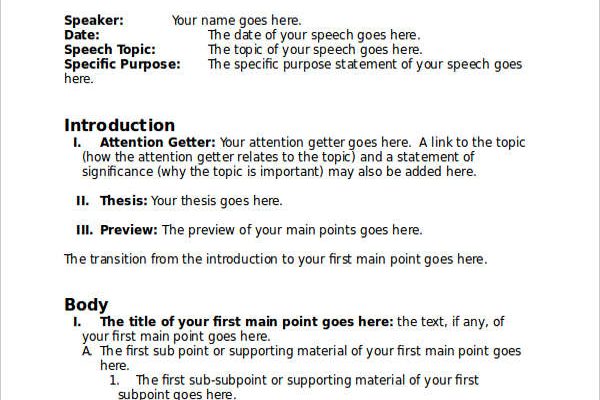
A well-structured speech is essential for effective communication, and creating an outline for your speech allows you to organize your thoughts in a coherent manner. A speech outline enables the speaker to present their ideas in a logical sequence, ensuring that listeners can follow along with ease. In this article, we will explore the steps to create a successful speech outline.
1. Understand the purpose of your speech
Before you begin outlining your speech, it’s important to identify the purpose behind it. Are you trying to persuade your audience about a particular issue, inform them about a topic, or entertain them with a story? Knowing your purpose will guide you in crafting an engaging narrative.
2. Define your audience
Consider the demographics and interests of your audience when developing a speech outline. What are their expectations? What topics or perspectives might be most appealing to them? Tailoring your speech to your audience will increase its effectiveness and resonance.
3. Organize your main points
Identify the key points you want to convey in your speech, focusing on concepts and ideas that align with your purpose and resonate with your audience. These main points should be arranged in a logical order, ensuring that each point flows seamlessly into the next.
4. Develop supporting points
For each main point, create supporting points that provide evidence or examples to reinforce your argument. These supporting points may consist of facts, statistics, anecdotes, or quotes from experts. Make sure that all supporting points directly relate back to the main point they are meant to uphold.
5. Create an introduction
A captivating introduction is crucial for engaging your audience from the very beginning. Your introduction should concisely state the topic of your speech and pique curiosity about what’s to come. You may use an intriguing question, shocking fact, or powerful anecdote to hook your listeners’ attention.
6. Write a strong conclusion
In the concluding part of the outline, you should emphasize your main points and tie them together in a way that reinforces your overall message. Restate your key points in a summarized manner and end with a final thought, call to action, or memorable takeaway for your audience.
7. Add transitions
To create a fluid, seamless experience for listeners, you need to include smooth transitions between each section of the speech. Connect your ideas with transitional phrases or sentences to guide your audience from one point to another.
8. Rehearse and revise
Once you have completed the speech outline, it is crucial to rehearse your content out loud. This practice will reveal any areas that need improvement and ensure that you are comfortable conveying the information. Revise your outline as needed based on feedback from yourself or others.
In conclusion, crafting a successful speech outline requires time and effort but ultimately ensures a well-structured, engaging presentation. By following these steps, you will be more prepared to deliver an impactful speech that resonates with your audience and effectively communicates your intended message. So go ahead and use this guide as a starting point for drafting the perfect speech outline!
5 Ways to Get Evidence Thrown out ...
3 ways to increase relative humidity in ....
Matthew Lynch
Related articles more from author.

3 Ways to Sew Fur Pelts Together

3 Ways to Overcome Depersonalization

3 Ways to Calculate the Time Signature of a Song

3 Easy Ways to Treat Numbness in Legs and Feet

How to Harvest Yarrow: 9 Steps

How to Draw an Eggplant: 5 Steps
All Formats
Outline Templates
9+ formal outline templates – samples, examples.
When it comes to making all kinds of different documents, you may be wise to make an outline as a guide. This can take the form of an essay outline , a research outline, or any other kind. And in that case, you may want to make use of outline templates to help you.

Formal Report Outline Template
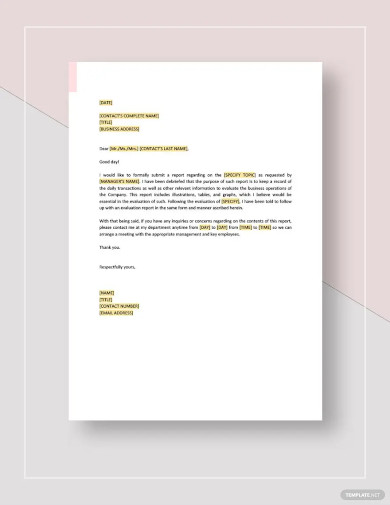
- Google Docs
- Apple Pages
Formal Letterhead Outline Template

Free Outline of Formal Essay
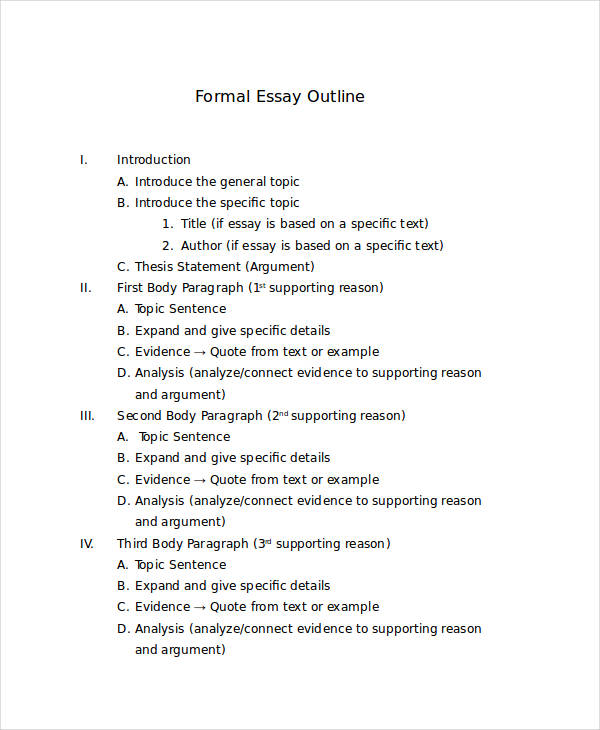
Free Formal Report Outline
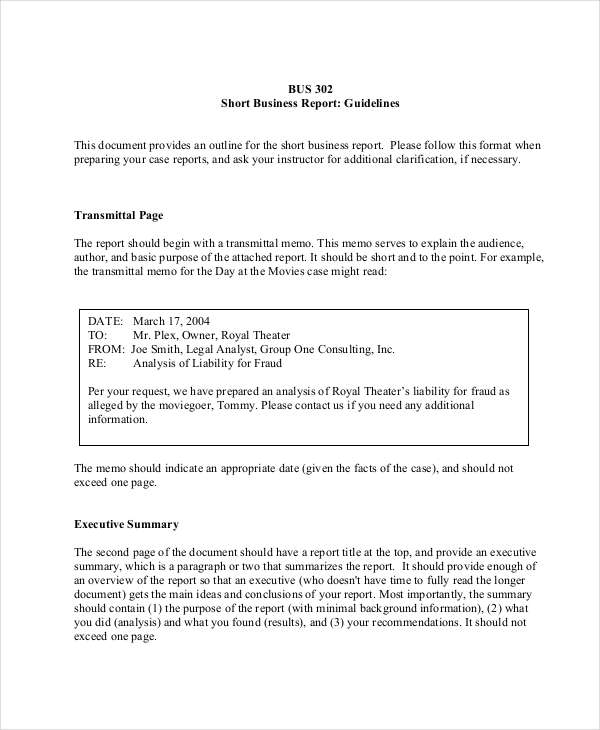
Free Formal Speech Outline
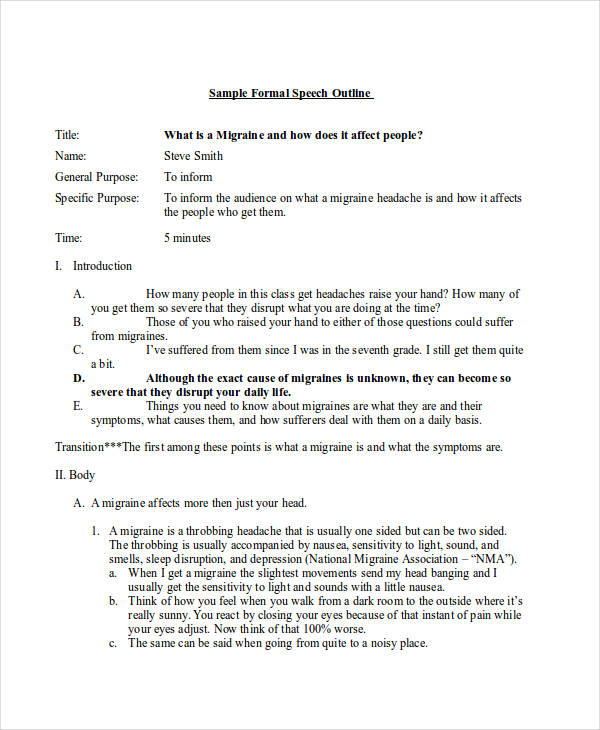
Blank Formal Outline
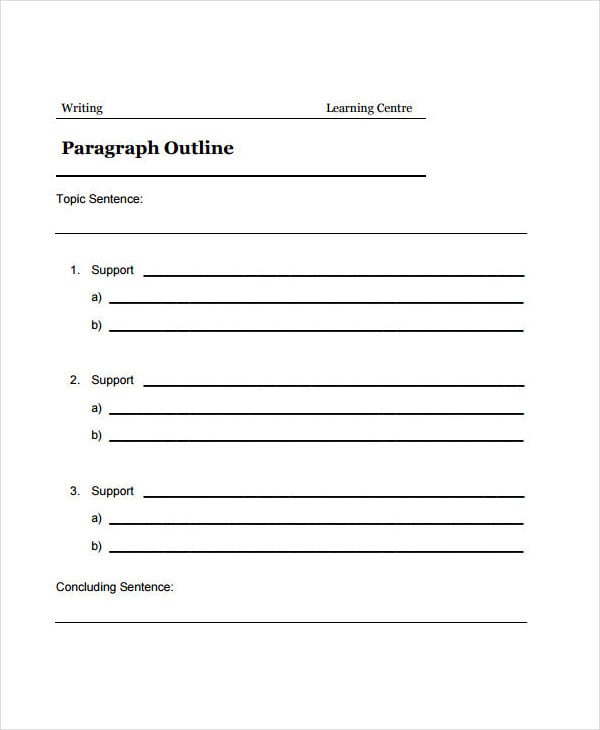
Free Formal Outline Sample
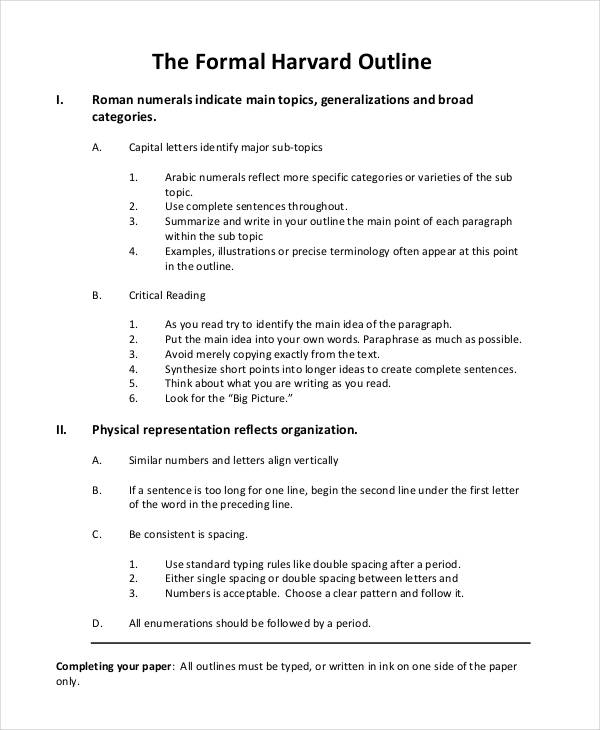
What Is a Formal Outline Format?
- Logical order . This means making sure that your paper flows naturally from topic to topic so as to ensure a sense of order.
- Consistent patterns . If you write your outline in one way, you should stick to it for the whole outline so as to maintain that pattern.
- General to specific points . Your paper will generally start with general points and make its way to increasingly specific points, as you can see with subheadings.
How to Create a Formal Outline
- Make sure to place your thesis statement on top of the page, so as to state the basic point of your work.
- Arrange each topic in order as a list .
- Each main topic should be highest on each group, with its subtopics under it, and their subtopics under them.
- Decide if you want to use sentences or phrases first, then stick with one or the other consistently.
Formal Research Paper Outline
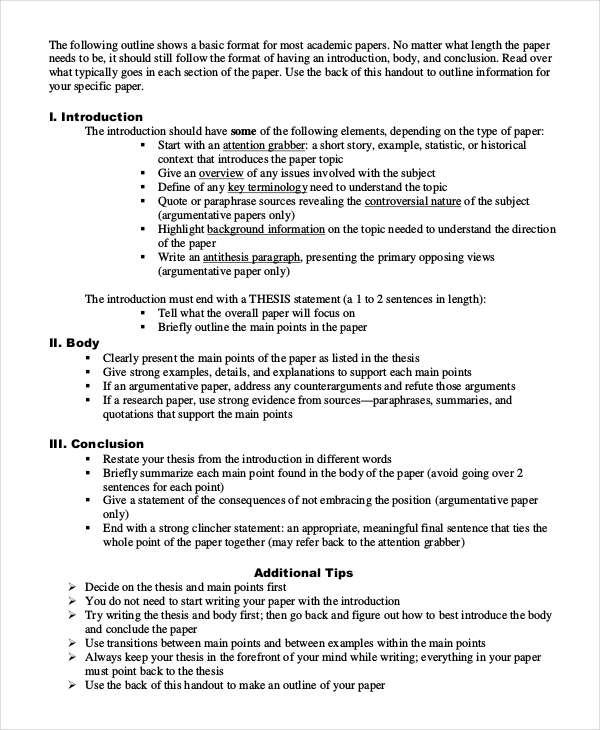
Example of Formal Outline
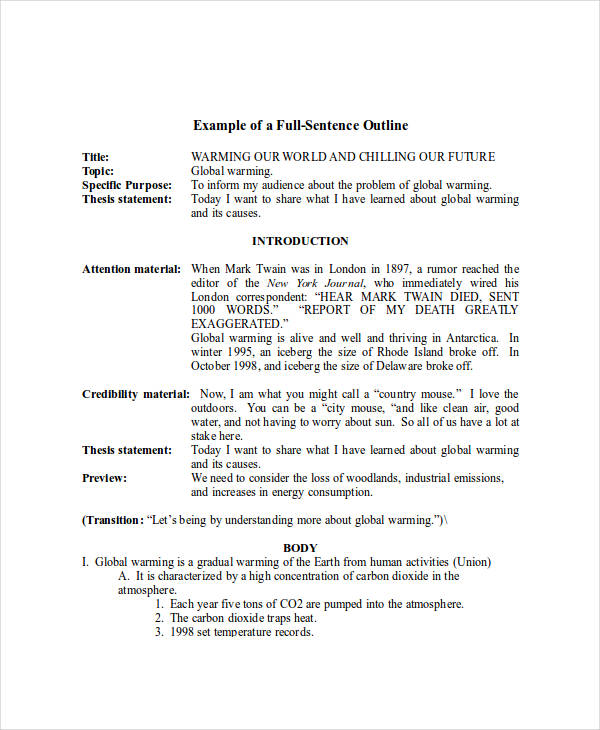
Free Formal Outline of Training
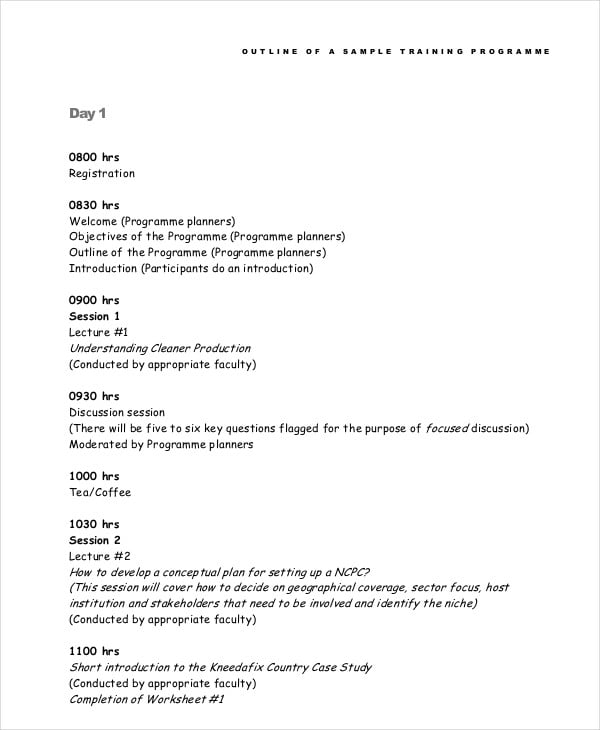
Do’s and Don’ts of Using a Formal Outline Template
- Do make sure that subgroups have more than one category , so as to further divide the larger category. If you cannot divide the category, then do not bother.
- Do stay consistent with your pattern of writing. This allows the audience to focus on the content rather than the format.
- Do remember that the higher categories are the most general categories , and that the sub-categories are meant to be more specific.
- Do not forget to include the thesis statement at the top of the page. This statement is a basic summary of your entire outline, and all the categories are ways of specifying it further.
More in Outline Templates
Formal debut invitation template, free blank invitation template, wedding invitation template, formal school principal invitation letter template, wedding convention invitation template, international seminar invitation for students in chea template, drug awareness invitation, prayer worship invitation, lingerie shower bridal party invitation, black gold lingerie bridal shower invitation.
- 10+ Training Outline Templates – PDF, Word, Apple Pages
- 24+ Autobiography Outline Templates & Samples – DOC, PDF
- 10+ Project Proposal Outline in Google Docs | MS Word | Pages | Editable PDF | InDesign | Photoshop | Publisher | PDF
- 12+ Literature Review Outline Templates – PDF, DOC
- 15+ Thesis Outline Templates – Sample, Example
- 11+ Outline Report Templates in Google Docs | Word | Pages | PDF
- 10+ Production Outline Templates
- 12+ Project Outline Templates in Google Docs | Word | Pages | PDF | XLS
- 15+ Meeting Outline Templates in PDF | DOC
- 8+ Project Proposal Outline Templates
- 12+ Outline Templates in Apple Pages
- 10+ Outline Templates in Word
- 10+ Outline Templates
- 15+ Topic Proposal Outline Templates – PDF, Word
- 12+ Research Project Proposal Outline Templates – PDF, Word, Pages
File Formats
Word templates, google docs templates, excel templates, powerpoint templates, google sheets templates, google slides templates, pdf templates, publisher templates, psd templates, indesign templates, illustrator templates, pages templates, keynote templates, numbers templates, outlook templates.
- Dealing with Grief
- Online Grief Counseling
- Loss of Parents
- Loss of Spouse
- Loss of Siblings
- Loss of Children
- Children and Grief
- Relationship Grief
- Alzheimer's Grief
- Disenfranchised Grief
- Coping with Suicide
- Other Types of Grief
- Stories of Grief
- Frequently Asked Questions
- Grief Forum
- Planning a Funeral
Funeral Flowers
Funeral Poems
- Funeral Eulogies
- Funeral Caskets and Urns
- Sympathy Gifts
- Sympathy Baskets
- Sympathy Cards
- Words of Sympathy
- Memorial Jewelry
- Memorial Trees
- Pet Loss Grief
- Pet Memorial Jewelry
- Pet Sympathy Cards and Gifts
Online Counseling
Keepsake Store
Free Eulogy Templates and Tips for the Perfect Send Off
Our printable free eulogy templates will help you to create the perfect funeral speech. Scroll down for the printouts.
You’re asked to speak at a funeral and you have a short period of time to gather your thoughts and prepare your speech. Experiencing nervousness is completely normal, especially while you’re coping with grief and sorrow from the loss. It may feel like an overwhelming task. Which of the many details of their life do you include? How long should it be? What should you say?
Writing a eulogy doesn’t have to be scary. Even if you aren’t a writer or public speaker, using the guidelines below, you will be able to write and deliver a meaningful and heartfelt speech.
Preparing to Write a Eulogy - Brainstorming
Begin by thinking of things you would be comfortable sharing about this person. The blank page is less intimidating if you start jotting down notes in each of the outline categories below. You won’t use every fact or memory, but will choose key pieces to include in the template. (Scroll down for ideas if the loss is of a child).
Eulogy speech outline
- Thank everyone for coming.
- What was your relationship with the person?
- What are some key topics you’d like to share about them?
- Early life
- Was he/she born elsewhere or somewhere special?
- Is there anything interesting about their childhood and how it affected their life?
- Education and work, marriage and children
- Did he/she have a mentionable education or career?
- Jot down names of the family.
- Significant events and achievements, hobbies and service, beliefs and passions
- What stands out about them in these categories?
- Significant events can be anything specific to them or their family, whether positive or negative. What are some events that made an impact on their life?
- Achievements can be more than an award. Think of things that were important to them. Maybe he/she considered their children to be their biggest achievement.
- Take a moment to think about what meant a lot to them, what did they value?
- Write down several memories that come to mind when you think of this person.
- To make a resonating speech bring it full circle at the end. That means, try refer back to something in the closing that you mentioned in the opening.
- Lastly, thank everyone for coming to celebrate their life.

“Carve your name on hearts, not tombstones. A legacy is etched into the minds of others and the stories they share about you.”
Shannon L. Alder
If the eulogy is for a child, some of the above sections may not be appropriate. Avoid anger and despair over the loss of a young life. Instead, focus on positive memories and stories that honour their memory. Consider the following points in your brainstorming:
- Write your thoughts on how the death of a child affects those around them.
- What made the child special to you?
- Was there a favorite book or poem or song that you can share?
- What were the child’s favorite things?
- What’s your favorite memory of them?
If you get stuck brainstorming or populating the template, you have options. You can ask family or friends to provide details or recall stories about the deceased. If you have access to photo albums, see what memories start to surface as you flip through. Don’t forget social media accounts, reviewing a person’s profile, feed, and photos can give you insights into their lives.
Review the facts and memories you’ve written down. It’s perfectly okay to insert bits of humour into the eulogy, but avoid anything inappropriate or embarrassing. As you’re reviewing your notes, cross out anything in poor humour or that you don’t want to include. Circle or highlight what you definitely want to keep.
Now, take those ideas and pull it all together, into a template.
Example Eulogy Templates for Printing
Example Eulogy Template for an Adult Click here for the downloadable PDF.
OPENING
I’d like to begin by thanking everyone for coming to celebrate ________’s (name) life. ________ (name) was the most ________(adjective) person I’ve ever known and I know many of you would agree. He/She ________ (include a bit of information about the deceased here, perhaps a memory).
EARLY LIFE
_________ (name) was born on ________ (birthdate) in _______ (city). He/She was the
______ (first, second, only) child of ________ (father) and ________ (mother). His/her sisters and brothers are ________, ________, and ________ (add more or less as needed). His/her childhood was ________ (include a bit of information about the deceased here, perhaps a memory or a humorous story about the siblings).
EDUCATION AND WORK
_________ (name) went to _______ (name of schools) and graduated with ________ (name of degree or training). He/She spent most of her career at ________ (name of company) as a _______ (name of position). He/She ________ (include a bit of information about the deceased here, perhaps a memory. What was his/her work ethic? Did he/she enjoy the work?).
MARRIAGE AND CHILDREN
In ______ (year) ________ (name) met _______ (spouse) and they were married in_____ (year). They had ___ (number) children: _______, _______, and _______ (names of children). Last year, ______ (name) and _______ (spouse) celebrated their _____ (number) wedding anniversary. He/She ________ (include additional information about the family, perhaps a funny or sweet memory).
SIGNIFICANT EVENTS AND ACHIEVEMENTS
In ______ (year), ______ (name) received the award of ______ (award). This award was meaningful to him/her because ______ (reason). He/She ________ (include additional information available, if it’s significant).
HOBBIES AND SERVICE / BELIEFS AND PASSIONS
______ (name) was active in the ________ (church, community, volunteer, etc). He/She spent many hours doing _______ (activity) and was known for ________ (descriptor). ______ (name) was passionate about ______ (passion). He/She ________ (include additional comments or memories about their extra-curricular activities).
My favorite memory of ______ (name) is that time when ______ (memory). (try to tie this memory back to their character – how the deceased was as a person).
The world is a sadder place without ______ (name) in our lives. But ______ (name) touched each and every one of us and has left us with memories we will cherish forever. Thank you.

Eulogy Template for a Child Click here for the downloadable PDF.
I’d like to begin by thanking everyone for coming to celebrate ________’s (name) life. ________ (name) was the most ________(adjective) child I’ve ever known. He/She ________ (include a bit of information about the child here, perhaps a memory).
______ (first, second, only) child of ________ (father) and ________ (mother). His/her sisters and brothers are ________, ________, and ________ (add more or less as needed). His/her childhood was ________ (include a bit of information about the child here, perhaps a memory or a humorous story about the siblings).
MEMORIES AND STORIES
My favorite memory of ______ (name) is that time when ______ (memory). (Use this section to share the memories and stories about the child. Share their favorite things, their relationships with friends and family, what made them laugh.
CLOSING (an appropriate poem, perhaps the child’s favorite)
“Perhaps they are not stars, but rather openings in heaven where the love of our lost ones pours through and shines down upon us to let us know they’re happy.” - Eskimo Proverb

Tips on Speaking the Eulogy
- Read the eulogy out loud several times and if you trip on any words, consider editing to make it easier to read next time.
- Practice several times each day leading up to the event, it will prepare you for the tougher parts of the eulogy. Practice in front of the mirror. Practice in front of family or friends. Practice while standing up, as if you were at the service. Practice looking at the audience and referring to your note cards.
- Time yourself to ensure you are around your target: no more than 5-10 minutes.
- Your speech doesn’t have to be memorized, but the more you practice the less you’ll need to read and the more natural you will sound. You may feel comfortable switching to notecards with bullet points or you may prefer to keep to the script. Do what feels best.
- You may fear being overly emotional or breaking down. Showing your emotion is perfectly normal. Focusing on the words on the page will help you maintain your composure.
- No matter how you choose to prepare, the most important thing is to give the best speech you can give; a speech from the heart.
Related Pages:
Funeral Speech Examples for Mother, Father, Friends and More
- Grief and Sympathy Home
- Funeral Speeches and Eulogies
- Free Eulogy Templates
For Remembrance:
Sales from our pages result in a small commission to us which helps us to continue our work supporting the grieving.

Memorial Jewelry to Honour a Loved One
Check out our lovely range of memorial jewelry for any lost loved one. Pendants, necklaces, rings or bracelets, we have them all in all kinds of styles. Choose for yourself or buy as a sympathy gift.
Click here to see our selection

Create an Online Memorial Website
Honour your loved one with their own memorial website. Share photos, videos, memories and more with your family and friends in a permanent online website. Free for basic plan with no ads.
Find out more here.
Keep in touch with us:
Sign up for our newsletter and receive: "the 10 most important things you can do to survive your grief and get on with life".
Our free downloadable and printable document "The 10 Most Important Things You Can Do To Survive Your Grief And Get On With Life" will help you to be positive day to day.
The 10 points are laid out like a poem on two pretty pages which you can pin on your fridge door to help you every day!
All you have to do to receive this free document is fill in your email address below.
You will also receive our newsletter which we send out from time to time with our newest comforting and helpful information. You can unsubscribe any time you like, and don't worry, your email address is totally safe with us.
NEW BONUS - Also receive a copy of our short eBook - '99 Ways to Spot a Great Grief Counselor'. Available for instant download as soon as you sign up. Never waste money on poor counseling again!
Join us on Facebook for articles, support, discussion and more. Click 'Like' below.
Grief and Sympathy
Would you prefer to share this page with others by linking to it?
- Click on the HTML link code below.
- Copy and paste it, adding a note of your own, into your blog, a Web page, forums, a blog comment, your Facebook account, or anywhere that someone would find this page valuable.
Find us here:
Sales made via this site will result in a small commission to us which enables us to continue our work helping those who are grieving. This does not affect the price you are charged and we will only ever recommend services and products in which we have complete faith.

Expert and Effective Online Counseling - Get Started Now
Self-help hypnosis downloads.

Try gentle therapy using relaxing hypnotherapy tracks in the privacy of your own home.
Click here to find out more.

Copyright Elizabeth Postl e RN, HV, FWT and Lesley Postle - GriefandSympathy.com 2012-2024
Any information provided on this website is general in nature and is not applicable to any specific person.
For specific advice, please consult a medical practitioner or qualified psychologist or counselor.
SiteMap About Us Contact Us
Affiliate Disclosure Privacy Policy
Powered by Solo Build It

IMAGES
VIDEO
COMMENTS
3.3 Explanatory Speech. 3.4 Demonstration Speech. 4 Informative Speech Outline Templates. 5 Checklist for Your Informative Speech. 5.1 Eye Contact. 5.2 Tone of Your Voice. 5.3 Expressive Hand and Body Gestures. 6 Informative Speech Samples. 7 Tips for Your Informative Speech from a Professional.
1. choosing a topic, 2. audience analysis, 3. choosing the best organizational pattern to fit your speech purpose, 4. what to put in each part of your speech: introduction, body and conclusion. a printable speech outline template to download. links to 2 completed examples of speech outlines (a demonstration and a persuasive speech.
When outlining your speech, make sure to decide how much time you'd like to give each of your main points. You might even consider setting specific timers during rehearsals to get a real feel for each part's duration. Generally speaking, you should allot a fairly equal amount of time for each to keep things balanced.
Step 1: open the speech with a greeting and introduction. As a matter of courtesy, it is a good thing to open the speech with a greeting. Follow this by introducing yourself. Take time also to thank those who have attended that event as well as its organizers. Lastly, thank the person who asked you to arise and speak.
The outline for a public speech, according to COMM 101 online textbook The Public Speaking Project, p.p. 8-9. Use these samples to help prepare your speech outlines and bibliographies: Sample Speech Preparation Outline. This type of outline is very detailed with all the main points and subpoints written in complete sentences. Your bibliography ...
2. Body. The body section allows you to provide details of the particular topic of your speech. Section 1. Write the main idea of the section. Provide supporting details, examples, and evidence to support the idea. Smoothly transition to the next main point of your speech. Section 2.
SPEECH OUTLINE TEMPLATE. Topic: General Purpose: Specific Purpose: Thesis: INTRODUCTION. Attention Getter: Connect With Audience: Establish Credibility: Thesis Statement: Preview Main Points: BODY (3-4 Main Points for a 5-7 minute speech) I. Main Point #1 (full sentence): A. Sub-Point: 1. Supporting Point:
As you can see, knowing that you want to inform your audience is just a small part of your speech. To make your speech as effective as possible, write with the right type of speech in mind. 1. Choose Your Topic. Before starting your informative speech outline example, you need to know what you're writing about.
Rebuttal or Response. Conclusion. 1. Summary of main points. 2. Restate your thesis. 3. Memorable closing statement. Let's break it down a little so you have a better idea of what each of these points means.
Ideas for your persuasive speech outline 1. Structure of your persuasive speech. The opening and closing of speech are the most important. Consider these carefully when thinking about your persuasive speech outline. A strong opening ensures you have the audience's attention from the start and gives them a positive first impression of you.
Check them out! 📚 Universal. Our informative speech outline generator can be used for different types of assignments, including speeches, essays, capstone projects, and more. 🎛️ Customizable. You can choose the assignment type and specify your topic to get a precise result. Point out the required number of paragraphs for some speech types.
29+ Speech Outline Templates - PDF, DOC. When you download a free speech outline template sample, you will find that this premium template helps you to clarify what you wish to say to the audience as well as organize all the print material you have in an easy and reliable manner. The Outline Template decreases the burden of having to draw up ...
Reason 3 ( Provide one reason as to why listeners should act or think the way your thesis suggests.) Example 1 - Support for the reason given above. Example 2 - Support for the reason given above. The most important part of a persuasive speech is the conclusion, second to the introduction and thesis statement.
Write a strong conclusion. In the concluding part of the outline, you should emphasize your main points and tie them together in a way that reinforces your overall message. Restate your key points in a summarized manner and end with a final thought, call to action, or memorable takeaway for your audience. 7. Add transitions.
Informative Speech Organizational Patterns You may use any of the following four organizational patterns for your informative speech. Your choice should match the subject matter you have chosen to research. There is a simple outline format at the end for you to copy/paste and adapt into a document to create your informative speech outline. Don't
Essay outlines can be used for any college essay, research papers, a contrast essay, speech writing, or an expository essay. There are a range of essay outline templates to use, and they vary depending on the style of essay you are writing. These include: Argumentative essay outline. Narrative essay outline. Contrast essay outline.
Persuasive Speech Outline Template (To save a copy for yourself choose File>Download as or File>make a copy. Cheers!) 1. Introduction. a. Hook/Attention grabber. b. Background and context. c. Thesis statement. 2. Body: Evidence to support your thesis. a. Claim 1. i. Evidence from source(s) to support claim. ii. Analysis/Commentary. b. Claim 2. i.
6+ Persuasive Speech Outline Template - DOC, PDF. With the ill-effects of the twenty first century urban and suburban maladies, more and more people have become disgruntled with public speakers. To deliver a persuasive you need valid iron-clad arguments, rhetoric and the occasional tension removing aside. It would be extremely beneficial if ...
Before you write your own script, it can be helpful to have a podcast script example PDF to give you a starting point. In this example, each section includes a spot for your main podcast topics, segment duration, key points, and sponsor ads placed at the beginning, middle, and end of the episode. Intro: Duration: ( ___) Set the stage for your ...
Expository essay outline. Claim that the printing press marks the end of the Middle Ages. Provide background on the low levels of literacy before the printing press. Present the thesis statement: The invention of the printing press increased circulation of information in Europe, paving the way for the Reformation.
Offer some more specific background information (as needed). 3. Provide the title of the piece and the author's name if the essay is about a specific book/poem/article/passage. C. Thesis Statement 1. State your topic and position. Remember that a thesis = claim + reasons. 2. Outline your main points and ideas.
9+ Formal Outline Templates - Samples, Examples. When it comes to making all kinds of different documents, you may be wise to make an outline as a guide. This can take the form of an essay outline, a research outline, or any other kind.And in that case, you may want to make use of outline templates to help you.
Free Eulogy Templates and Tips for the Perfect Send Off. Our printable free eulogy templates will help you to create the perfect funeral speech. Scroll down for the printouts. You're asked to speak at a funeral and you have a short period of time to gather your thoughts and prepare your speech. Experiencing nervousness is completely normal ...